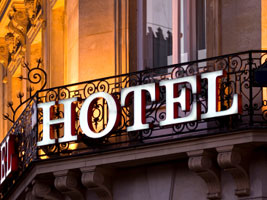This page offers information and resources for businesses (also known as public accommodations) covered by Title III of the Americans with Disabilities Act (ADA), which outlines how to make goods and services accessible and available to customers with disabilities.
Some businesses that are covered by Title III are also covered by Title I, which addresses employment of workers with disabilities. Visit our “Employers” page for information on hiring, accommodations, and other employment issues.
Q1. Why should I learn how to comply with the Americans with Disabilities Act (ADA)?
A1. The ADA recognizes that, for people with disabilities to participate in the everyday activities in their communities, they need to have access to the goods and services provided by your business. Imagine looking forward to a night out with friends, but being unable to enter any of the restaurants in town. For that matter, imagine being unable to enter the grocery store, the beauty parlor, the bank, the dry cleaners or any of the other small businesses in your community.
Q2. Are there any benefits for small businesses to offset the costs associated with ADA compliance?
A2. Americans with disabilities represent a lucrative consumer market more than 54 million strong with as much as $220 billion in discretionary income – twice as much as the teen market. Business owners should remember that good access means good business. The simple measures taken to provide access to people with disabilities also will increase foot traffic by attracting other portions of the population, such as senior citizens, parents with small children in strollers, and people with temporary injuries.
According to a recent GAO report, implementing the access provisions of the ADA has increased revenues in the hotel and hospitality industry by 12 percent. People with disabilities gravitate by necessity to business establishments that provide good access and will bring other customers with them to the restaurants, stores and service establishments they patronize.
Q3. Does the government offer tax incentives to help meet the cost of ADA compliance?
A3. Yes. Federal tax incentives are available to help meet the cost of ADA compliance. The Internal Revenue Code allows a deduction of up to $15,000 per year for expenses associated with the removal of qualified architectural and transportation barriers. Eligible small businesses also may receive a tax credit for certain costs of compliance with the ADA. Qualifying businesses may claim a credit of up to 50 percent of eligible access expenditures that exceed $250 but do not exceed $10,250. State and local governments may have additional tax incentives.
Q4. How much does it cost to comply with the ADA?
A4. Private entities that own, operate, lease, or lease to a business that serves the public must remove barriers when it is “readily achievable,” which means easily accomplishable without much difficulty or expense. The “readily achievable” requirement is based on the size and resources of the business. So, businesses with more resources are expected to take a more active role in removing barriers than businesses with fewer resources.
Q5. Do I need to make expensive changes even when sales are slow and profits are down?
A5. The ADA recognizes that economic conditions vary. When a business has resources to remove barriers, it is expected to do so; but when profits are down, barrier removal may be reduced or delayed. There are many simple modifications that small businesses can make even when resources are limited.
Q6. What are examples of simple modifications that would be readily achievable in most cases?
A6. Examples include the simple ramping of a few steps, the installation of grab bars where only routine reinforcement of the wall is required, the lowering of telephones, and other modest adjustments. Similarly, restaurants may need to rearrange tables, and stores may need to adjust their layout of racks and shelves in order to facilitate access for wheelchair users.
Q7. What if barrier removal is not readily achievable, what kinds of alternative steps are required by the ADA?
A7. Alternatives may include such measures as in-store assistance for removing articles from inaccessible shelves, home delivery of groceries, or coming to the door to receive or return dry cleaning.
Q8. What are some examples of things a business might need to do to communicate effectively with a customer who has a sensory disability like blindness or deafness?
A8. A variety of methods, aids, or services might be used, depending on the situation, the customer’s disability and mode of communication, and other factors. Examples might include:
- Writing notes back and forth to complete a simple transaction with a customer who is deaf
- Hiring an interpreter to complete in-depth or complex transactions with a customer who is deaf and uses sign language
- Providing assistive listening equipment to enable a customer who is hard of hearing to attend a movie, performance, or lecture
- Reading printed materials (e.g. menu items, prices) for a customer who is blind or has low vision
- Providing printed materials in accessible formats such as large print or Braille
- Implementing accessibility features in web sites and telecommunication systems to enable customers to access online ordering and other electronic business applications
Q9. Do all businesses have obligations under Title III of ADA?
Type of Establishment Examples












Q10. What are some examples of architectural barriers?
A10. Architectural barriers are physical features that limit or prevent people with disabilities from obtaining the goods or services that are offered.
Common examples include:
- Parking spaces that are too narrow and/or lack an adjacent access aisle for people who use wheelchairs and other mobility devices
- Steps at the entrance of a store or inside the store, where they are necessary to access goods or services
- Round doorknobs or door hardware that is difficult to grasp
- Aisles that are too narrow for a person using a wheelchair, electric scooter, or a walker
- High counters at checkout aisles or where items are available
- Narrow checkout aisles at cash registers
- Fixed tables in eating areas that are too low to accommodate a person using a wheelchair or fixed seats in eating areas that prevent a person using a wheelchair from pulling under the table
Q11. How can I get more information about how to comply with the ADA?
A11. The Mid-Atlantic ADA Center offers a toll-free telephone information ; call 1-800-949-4232 (V/TTY) and staff will answer your questions and provide you with more detailed information.
Additional Resources and Publications
U.S. Department of Justice:
Expanding your Market: Customers with Disabilities Mean Business (HTML)
Expanding your Market: Customers with Disabilities Mean Business
Expanding your Market: Tax Incentives (HTML)
Expanding your Market: Tax Incentives
Reaching out to Customers with Disabilities web course : This free, self-paced online course includes ten short modules to address topics such as removing barriers, communicating with customers, policies and procedures, maintaining accessibility, transportation issues, and more.
ADA Quick Tips
Customer Service (PDF)
Customer Service (text file)
Tax Incentives (PDF)
Tax Incentives (text file)
Sign Language Interpreters (PDF)
Sign Language Interpreters (text file)
Visit our Publications page for a more comprehensive list of business-related publications.